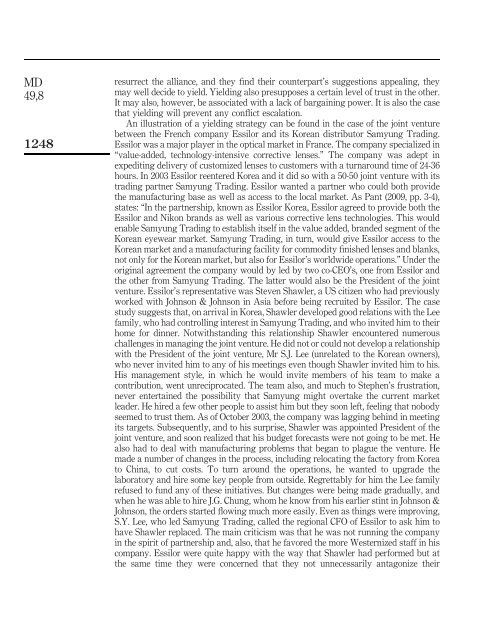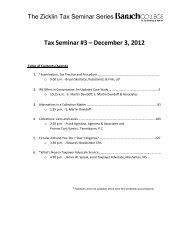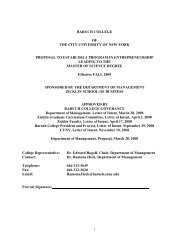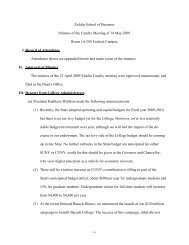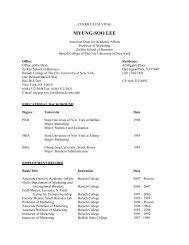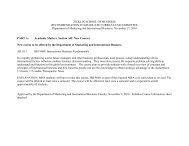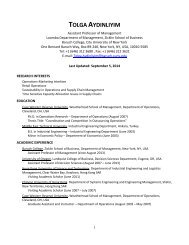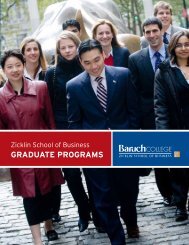alliances a strategic framework
Download - zicklin : school of business - CUNY
Download - zicklin : school of business - CUNY
- No tags were found...
You also want an ePaper? Increase the reach of your titles
YUMPU automatically turns print PDFs into web optimized ePapers that Google loves.
MD<br />
49,8<br />
1248<br />
resurrect the alliance, and they find their counterpart’s suggestions appealing, they<br />
may well decide to yield. Yielding also presupposes a certain level of trust in the other.<br />
It may also, however, be associated with a lack of bargaining power. It is also the case<br />
that yielding will prevent any conflict escalation.<br />
An illustration of a yielding strategy can be found in the case of the joint venture<br />
between the French company Essilor and its Korean distributor Samyung Trading.<br />
Essilor was a major player in the optical market in France. The company specialized in<br />
“value-added, technology-intensive corrective lenses.” The company was adept in<br />
expediting delivery of customized lenses to customers with a turnaround time of 24-36<br />
hours. In 2003 Essilor reentered Korea and it did so with a 50-50 joint venture with its<br />
trading partner Samyung Trading. Essilor wanted a partner who could both provide<br />
the manufacturing base as well as access to the local market. As Pant (2009, pp. 3-4),<br />
states: “In the partnership, known as Essilor Korea, Essilor agreed to provide both the<br />
Essilor and Nikon brands as well as various corrective lens technologies. This would<br />
enable Samyung Trading to establish itself in the value added, branded segment of the<br />
Korean eyewear market. Samyung Trading, in turn, would give Essilor access to the<br />
Korean market and a manufacturing facility for commodity finished lenses and blanks,<br />
not only for the Korean market, but also for Essilor’s worldwide operations.” Under the<br />
original agreement the company would by led by two co-CEO’s, one from Essilor and<br />
the other from Samyung Trading. The latter would also be the President of the joint<br />
venture. Essilor’s representative was Steven Shawler, a US citizen who had previously<br />
worked with Johnson & Johnson in Asia before being recruited by Essilor. The case<br />
study suggests that, on arrival in Korea, Shawler developed good relations with the Lee<br />
family, who had controlling interest in Samyung Trading, and who invited him to their<br />
home for dinner. Notwithstanding this relationship Shawler encountered numerous<br />
challenges in managing the joint venture. He did not or could not develop a relationship<br />
with the President of the joint venture, Mr S.J. Lee (unrelated to the Korean owners),<br />
who never invited him to any of his meetings even though Shawler invited him to his.<br />
His management style, in which he would invite members of his team to make a<br />
contribution, went unreciprocated. The team also, and much to Stephen’s frustration,<br />
never entertained the possibility that Samyung might overtake the current market<br />
leader. He hired a few other people to assist him but they soon left, feeling that nobody<br />
seemed to trust them. As of October 2003, the company was lagging behind in meeting<br />
its targets. Subsequently, and to his surprise, Shawler was appointed President of the<br />
joint venture, and soon realized that his budget forecasts were not going to be met. He<br />
also had to deal with manufacturing problems that began to plague the venture. He<br />
made a number of changes in the process, including relocating the factory from Korea<br />
to China, to cut costs. To turn around the operations, he wanted to upgrade the<br />
laboratory and hire some key people from outside. Regrettably for him the Lee family<br />
refused to fund any of these initiatives. But changes were being made gradually, and<br />
when he was able to hire J.G. Chung, whom he know from his earlier stint in Johnson &<br />
Johnson, the orders started flowing much more easily. Even as things were improving,<br />
S.Y. Lee, who led Samyung Trading, called the regional CFO of Essilor to ask him to<br />
have Shawler replaced. The main criticism was that he was not running the company<br />
in the spirit of partnership and, also, that he favored the more Westernized staff in his<br />
company. Essilor were quite happy with the way that Shawler had performed but at<br />
the same time they were concerned that they not unnecessarily antagonize their


